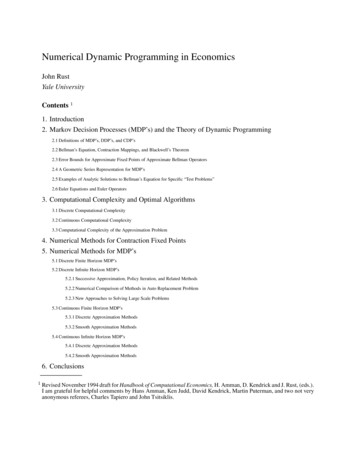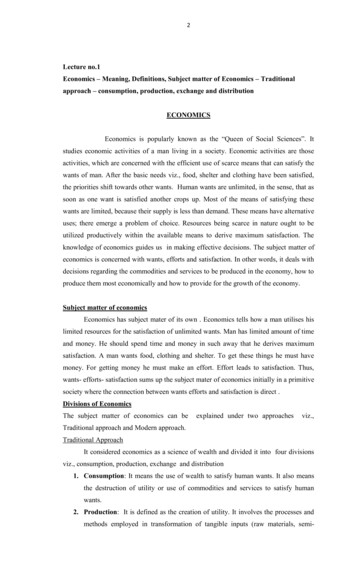
Transcription
Numerical Dynamic Programming in EconomicsJohn RustYale UniversityContents 11. Introduction2. Markov Decision Processes (MDP’s) and the Theory of Dynamic Programming2.1 Definitions of MDP’s, DDP’s, and CDP’s2.2 Bellman’s Equation, Contraction Mappings, and Blackwell’s Theorem2.3 Error Bounds for Approximate Fixed Points of Approximate Bellman Operators2.4 A Geometric Series Representation for MDP’s2.5 Examples of Analytic Solutions to Bellman’s Equation for Specific “Test Problems”2.6 Euler Equations and Euler Operators3. Computational Complexity and Optimal Algorithms3.1 Discrete Computational Complexity3.2 Continuous Computational Complexity3.3 Computational Complexity of the Approximation Problem4. Numerical Methods for Contraction Fixed Points5. Numerical Methods for MDP’s5.1 Discrete Finite Horizon MDP’s5.2 Discrete Infinite Horizon MDP’s5.2.1 Successive Approximation, Policy Iteration, and Related Methods5.2.2 Numerical Comparison of Methods in Auto Replacement Problem5.2.3 New Approaches to Solving Large Scale Problems5.3 Continuous Finite Horizon MDP’s5.3.1 Discrete Approximation Methods5.3.2 Smooth Approximation Methods5.4 Continuous Infinite Horizon MDP’s5.4.1 Discrete Approximation Methods5.4.2 Smooth Approximation Methods6. Conclusions1Revised November 1994 draft for Handbook of Computational Economics, H. Amman, D. Kendrick and J. Rust, (eds.).I am grateful for helpful comments by Hans Amman, Ken Judd, David Kendrick, Martin Puterman, and two not veryanonymous referees, Charles Tapiero and John Tsitsiklis.
7. References
21. IntroductionThis chapter surveys numerical methods for solving dynamic programming (DP) problems.The DP framework has been extensively used in economic modeling because it is sufficientlyrich to model almost any problem involving sequential decision making over time and underuncertainty. 2 By a simple re-definition of variables virtually any DP problem can be formulated asa Markov decision process (MDP) in which a decision maker who is in state s t at time t 1, . . . , Ttakes an action at that determines current utility u(st , at ) and affects the distribution of nextperiod’s state st 1 via a Markov transition probability p(st 1 st , at ). The problem is to determinenPoT β t u(s , a ) s s where Ean optimal decision rule α that solves V (s) max α Eααt t 0t 0denotes expectation with respect to the controlled stochastic process {s t , at } induced by thedecision rule α {α1 , . . . , αT }, and β (0, 1) denotes the discount factor. What makes theseproblems especially difficult is that instead of optimizing over an ex ante fixed sequence of actions{a0 , . . . , aT } one needs to optimize over sequences of functions {α0 , . . . , αT } that allow the expost decision at to vary as a best response to the current state of the process, i.e. a t αt (st ). Themethod of dynamic programming provides a constructive, recursive procedure for computing αusing the value function V as a “shadow price” to decentralize a complicated stochastic/multiperiodoptimization problem into a sequence of simpler deterministic/static optimization problems. 3 Ininfinite horizon problems V is the unique solution to a Bellman’s equation, V Γ(V ), where theBellman operator Γ is defined by:Γ(V )(s) max [u(s, a) βa A(s)ZV (s0 )p(ds0 s, a)],(1.1)and the optimal decision rule can be recovered from V by finding a value α(s) A(s) that attainsthe maximum in (1.1) for each s S. We review the main theoretical results about MDP’s in section2, providing an intuitive derivation Bellman’s equation in the infinite horizon case and showingthat the value function Vα corresponding to a policy α is simply a multidimensional generalizationof a geometric series. This implies that Vα can be computed as the solution to a system of linearequations, the key step in the Bellman 1955, 1957 and Howard 1960 policy iteration algorithm.The Bellman operator has a particularly nice mathematical property: Γ is a contraction mapping.2See Stokey and Lucas 1987 for examples of DP models in economic theory. See Rust 1994a, 1994b for examples ofof DP models in econometrics.3In finite horizon problems V actually denotes an entire sequence of value functions, V {V0T , . . . , VTT }, just as αdenotes a sequence of decision rules. In the infinite-horizon case, the solution (V, α) reduces to a pair of functions ofthe current state s.
3A large number of numerical solution methods exploit the contraction property to yield convergent,numerically stable methods for computing approximate solutions to Bellman’s equation, includingthe classic method of successive approximations. Since V can be recovered from α and vice versa,the rest of this chapter focuses on methods for computing the value function V , with separatediscussions of numerical problems involved in approximating α where appropriate. 4From the standpoint of computation, there is an important distinction between discrete MDP’swhose state and control variables can assume only a finite number of possible values, and continuousMDP’s whose state and control variables can assume a continuum of possible values. The valuefunctions for discrete MDP’s live in a subset B of the finite-dimensional Euclidean space R S (where S is the number of elements in S), whereas the value functions of continuous MDP’s livein a subset B of the infinite-dimensional Banach space B(S) of bounded, measurable real-valuedfunctions on S. Thus, discrete MDP problems can be solved exactly (modulo rounding errorin arithmetic operations), whereas the the solutions to continuous MDP’s can generally only beapproximated. Approximate solution methods may also be attractive for solving discrete MDP’swith a large number of possible states S or actions A .There are two basic strategies for approximating the solution to a continuous MDP: 1) discreteapproximation and 2) smooth approximation. Discrete approximation methods solve a finite stateMDP problem that approximates the original continuous MDP problem over a finite grid of points inthe state space S and action space A. Since the methods for solving discrete MDP’s have been welldeveloped and exposited in the operations research literature (e.g. Bertsekas, 1987, Porteus, 1980and Puterman, 1990, 1994), this chapter will only briefly review the standard approaches, focusinginstead on recent research on discretization methods for solving continuous MDP’s. Althoughsmooth approximation methods also have a long history (dating back to Bellman, 1957 Bellmanand Dreyfus, 1962 and Bellman, Kalaba and Kotkin 1963), there has been a recent resurgenceof interest in these methods as a potentially more efficient alternative to discretization methods(Christiano and Fisher, 1994, Johnson et. al. 1993, Judd and Solnick 1994, Marcet and Marshall,1994, and Smith 1991). Smooth approximation methods treat the value function V and/or thedecision rule α as smooth, flexible functions of s and a finite-dimensional parameter vector θ:examples include linear interpolation and a variety of more sophisticated approximation methods4Special care must be taken in problems with a continuum of actions, since discontinuities or kinks in numericalestimates of the conditional expectation of V can create problems for numerical optimization algorithms used torecover α. Also, certain solution methods focus on computing α directly rather than indirectly by first computing V .We will provide special discussions of these methods in section 5.
4such as polynomial series expansions, neural networks, and cubic splines. The objective of thesemethods is to choose a parameter θ̂ such that the implied approximations Vθ̂ or αθ̂ “best fit”the true solution V and α according to some metric. 5 In order to insure the convergence of asmooth approximation method, we need a parametrization that is sufficiently flexible to allow usto approximate arbitrary value functions V in the set B. One way to do this is via an expandingsequence of parameterizations that are ultimately dense in B in the sense that for each V B 6lim infθ Rk kVθ V k 0,k (1.2)where kV k sups S V (s) denotes the usual “sup-norm”. For example, consider an infinitehorizon MDP problem with state space S [ 1, 1]. A natural choice for an expanding family ofsmooth approximations to V isVθ (s) kXθi pi (s)(1.3)i 1where pi (s) cos (i cos 1 (s)) is the ith Chebyshev polynomial. 7 The Weierstrauss approximationtheorem implies that the Chebyshev polynomials are ultimately dense in the space B C[ 1, 1] ofcontinuous functions on [ 1, 1]. 8 Under the least squares criterion of goodness of fit, the problemis to choose a parameter θ Θ Rk to minimize the error function σN defined by:σN (θ) vuuXNut Vθ (si ) Γ̂(Vθ )(si ) 2 ,i 1(1.4)where Γ̂ is some computable approximation to the true Bellman operator Γ. Methods of this formare known as minimum residual (MR) methods since the parameter θ is chosen to set the residualfunction R(Vθ )(s) Vθ (s) Γ̂(Vθ )(s) as close to the zero function as possible. The philosophy ofthese methods is that if the true value function V can be well approximated by a flexible parametricfunction Vθ for a small number of parameters k, we will be able to find a better approximation to5Other variants of smooth approximation methods use nonlinear equation solvers to find a value θ that satisfies a set of“orthogonality conditions”. In finite horizon MDP’s interpolation methods are used to store the value function. Othermethods such as Johnson et. al. 1993 use local polynomial interpolation of V over a grid of points in S.6If the MDP problem has further structure that allows us to restrict the true value function to some subset of B such asthe space of continuous functions, C(S), then the limit in equation (1.2) condition need only for each V in this subset.7See Judd chapter 6 for a definition of Chebyshev and other families of orthogonal polynomials.8In fact we have the following error bound for equation (1.2): inf θ Rk kVθ V k b log(k)/k for some constant b 0.See Judd chapter 6 for a formal statement of this result and Rivlin 1969 for a proof.
5V in significantly less cpu time by minimizing an error function such as σN (θ) in (1.4) than by“brute force” discretization methods.At a sufficient level of abstraction the distinction between discrete and smooth approximationmethods starts to evaporate since discrete approximation based on N grid points can alwaysbe regarded as a particular way of parametrizing the solution to the MDP problem (e.g. asa simple linear spline function that interpolates VN at the N grid points). Also, as equation(1.4) illustrates, practical implementation of smooth approximation methods require discretizationmethods of various sorts to compute various integrals, to provide grid points for interpolation,knots for splines, and so forth. However there is a distinction between the two approaches that webelieve is key to understanding their relative strengths and weaknesses: Discrete approximationmethods focus on solving an approximate finite MDP problem whose associated Bellman operatorΓN : RN RN fully preserves the contraction mapping property of the true Bellman operatorΓ : B B. In addition, an approximate fixed point VN to ΓN typically preserves the monotonicityand concavity properties of the true value function V . Smooth approximation methods such as theminimum residual method outlined in equations (1.3) to (1.4) transform the MDP problem into theproblem of minimizing a smooth function σN (θ) that generally does not have any easily exploitablemathematical structure (beyond smoothness in θ). Furthermore the parametrized value functionVθ may not retain any of the concavity or monotonicity properties that are known to hold for thetrue solution V . Of course, there are exceptions to this distinction as well. Section 5 describesa discrete approximation method of Coleman 1990, 1993 that computes the optimal decisionrule α directly as the solution to a functional equation known as the Euler equation. The Eulerequation has an associated Euler operator that maps policy functions into policy functions justas the Bellman equation has an associated Bellman operator that maps value functions into valuefunctions. Unfortunately, the Euler operator is not a contraction mapping, which makes it moredifficult to derive error bounds and prove the convergence of iterative methods such as successiveapproximations. Another exception is the smooth approximation method of Judd and Solnick 1994that uses “shape preserving splines” to preserve concavity and monotonicity properties of V .Approximate solution methods force us to confront a tradeoff between the maximum allowable error in the numerical solution and the amount of computer time (and storage space) neededto compute it. Solution time will also be an increasing function of any relevant measure of thesize or dimension d of the MDP problem. It goes without saying that economists are interestedin using the fastest possible algorithm to solve their MDP problem given any specified values
6of ( , d). Economists are also concerned about using algorithms that are both accurate and numerically stable since the MDP solution algorithm is often embedded or “nested” as a subroutineinside a larger optimization or equilibrium problem. Examples include computing competitiveequilibria of stochastic general equilibrium models with incomplete markets (Hansen and Sargent,1993, Imrohoroğlu and Imrohoroğlu, 1993, McGuire and Pakes, 1994), maximum likelihood estimation of unknown parameters of u and p using data on observed states and decisions of actualdecision-makers (Eckstein and Wolpin, 1987, Rust, 1994 and Sargent, 1979), and computation andeconometric estimation of Bayesian Nash equilibria of dynamic games (McKelvey and Palfrey,1992). All of these problems are solved by “polyalgorithms” that contain MDP solution subroutines. 9 Since the MDP problem must be repeatedly re-solved for various trial sequences of the“primitives” (β, u, p), speed, accuracy, and numerical stability are critical.A large number of alternative solution methods have been proposed in the last 40 years. Bellman was one of the original contributors to this literature, with pioneering work on both discrete andsmooth approximation methods (e.g. the previously cited work on policy iteration and polynomialapproximations of the value function). Recently there has been considerable controversy in theeconomics literature about the relative merits of discrete versus smooth approximation methods forsolving continuous MDP problems. Part of the controversy arose from a “horse race” in the 1990Journal of Business and Economic Statistics (Taylor and Uhlig, 1990) in which a number of alternative solution methods competed in their ability to solve the classical Brock-Mirman stochasticgrowth model which we will describe in section 2.6. More recently Judd 1993 has claimed thatApproximating continuous-state problems with finite state Markov chains limits therange of problems which can be analyzed. Fortunately, state-space discretization isunnecessary. For the past thirty years, the standard procedure in Operations Researchliterature (see Bellman, 1963, Dantzig 1974, Daniel, 1976) has been to approximatevalue functions and policy rules over continuous state spaces with orthogonal polynomials, splines, or other suitable families of functions. This results in far fasteralgorithms and avoids the errors associated with making the problem unrealistically“lumpy”. (p. 3)This chapter offers some new perspectives on this debate by providing a conceptual frameworkfor analyzing the accuracy and efficiency of various discrete and smooth approximation methodsfor continuous MDP problems. The framework is the theory of computational complexity (Gareyand Johnson 1983, Traub and Woźniakowski 1980, and Traub, Wasilikowski and Woźniakowski9We will see that the MDP subroutine is itself a fairly complicated polyalgorithm consisting of individual subroutinesfor numerical integration, optimization, approximation, and solution of systems of linear and nonlinear equations.
7(TWW), 1988). We provide a brief review of the main results of complexity theory in section 3.Complexity theory is of particular interest because it has succeeded in characterizing the form ofoptimal algorithms for various mathematical problems. Chow and Tsitsiklis 1989 used this theoryto establish a lower bound on the amount of computer time required to solve of a general class ofcontinuous MDP’s. A subsequent paper, Chow and Tsitsiklis 1991, presented a particular discreteapproximation method — a multigrid algorithm — that is approximately optimal in a sense to bemade precise in section 5.3. Thus, we will be appealing to complexity theory as a way of findingoptimal strategies for finding optimal strategies.There are two main branches of complexity theory, corresponding to discrete and continuousproblems. Discrete (or algebraic) computational complexity applies to finite problems that can besolved exactly such as matrix multiplication, the traveling salesman problem, linear programming,and discrete MDP’s. 10 The size of a discrete problem is indexed by an integer d and the (worstcase) complexity, comp(d), denotes the minimal number of computer operations necessary tosolve the hardest possible problem of size d, (or if there is no algorithm capable of solvingthe problem). Continuous computational complexity theory applies to continuous problems suchas multivariate integration, function approximation, nonlinear programming, and continuous MDPproblems. None of these problems can be solved exactly, but in each case the true solution can beapproximated to within an arbitrarily small error tolerance . Problem size is indexed by an integerd denoting the dimension of the space that the continuous variable lives in (typically a subset ofRd ), and the complexity, comp( , d), is defined as the minimal computational cost (cpu time) ofsolving the hardest possible d-dimensional problem to within a tolerance of .Complexity theory enables us to formalize an important practical limitation to our abilityto solve increasingly detailed and realistic MDP problems: namely Bellman’s 1955 curse ofdimensionality. This is the well-known exponential rise in the amount of time and space requiredto compute the solution to a continuous MDP problem as the number of dimensions d s of the statevariable or the number of dimensions da of the control variable increases. Although one typicallythinks of the curse of dimensionality as arising from the discretization of continuous MDP’s, it alsooccurs in finite MDP’s that have many state and control variables. For example, a finite MDP withds state variables each of which can take on S 1 possible values has a total of S ds possiblestates. The amount of computer time and storage required to solve such a problem increasesexponentially fast as ds increases. Smooth approximation methods cannot escape the curse of10In the latter two problems we abstract from rounding error computer arithmetic.
8dimensionality: for example using the Chebyshev approximation in equation (1.3), the dimensionk of the parameter vector θ must increase at a sufficiently rapid rate as ds increases in order toguarantee that kVθ̂ V k . Indeed, the literature on approximation theory (Pinkus, 1985, Novak1988) shows that k must increase at rate (1/ )(d/r) in order to obtain uniform -approximationsof smooth multidimensional functions which are r-times continuously differentiable. Althoughthere are certain nonlinear approximation methods such as neural networks that can be shown torequire a polynomially rather than exponentially increasing number of parameters k to obtain approximations for certain subclasses of functions (i.e. only k O(1/ 2 ) parameters are requiredto approximate the subclass of functions considered in Barron 1993, and Hornik, Stinchombe andWhite 1992) are still subject to curse of dimensionality due to curse of dimensionality involved infitting the parameters θ of the neural net by some minimization such as nonlinear least squares: theamount of computer time required to find an -approximation to a global minimizer of an arbitrarysmooth function increases exponentially fast as the number of parameters k increases (Nemirovskyand Yudin, 1983), at least on a worst case basis. Variations of smooth approximation methods thatinvolve solutions of systems k nonlinear equations or which require multivariate interpolation orapproximation are also subject to the curse of dimensionality (Sikorski, 1985, TWW, 1988).Definition: A class of discrete MDP problems with ds state variables and da control variables is subjectto the curse of dimensionality if comp(ds , da ) Ω(2ds da ). A class of continuous MDP problems issubject to the curse of dimensionality ifcomp( , da , da ) Ω(1/ (ds da ) ). 11In the computer science literature problems that are subject to the curse of dimensionality are calledintractable. 12 If the complexity of the problem has an upper bound that only grows polynomiallyin d we say that the problem is in the class P of polynomial-time problems. Computer scientistsrefer to polynomial-time problems as tractable. 1311 The notation Ω denotes a “lower bound” on complexity, i.e. comp(d) Ω g(d) if limd g(d)/ comp(d) .12We prefer the terminology “curse of dimensionality” since the common use of the term “intractable” connotes aproblem that can’t be solved. Computer scientists have a specific terminology for problems that can’t be solved inany finite amount time: these problems have infinite complexity, and are classified as non-computable. However eventhough intractable problems are computable problems in the computer science terminology, as the problem grows largethe lower bound on the solution time grows so quickly that these problems are not computable in any practical sense.13Here again it is important to note the difference between the common meaning of the term “tractable” and the computerscience definition. Even so-called “tractable” polynomial-time problems can quickly become computationally infeasible if complexity satisfies comp(d) O(d k ) for some large exponent k. However it seems to be a fortunate act ofnature that the maximum exponent k for most common polynomial time problems is fairly small; typically k [2, 4].
9A large number of mathematical problems have been proven to be intractable on a worst casebasis. These problems include multivariate integration, optimization, and function approximation(TWW, 1988), and solution of multidimensional partial differential equations (PDE’s), and Fredhom integral equations (Werschulz, 1991). Lest the reader get too depressed about the potentialusefulness of numerical methods at the outset, we note that there are some mathematical problemsthat are not subject to the curse of dimensionality. Problems such as linear programming andsolution of ordinary differential equations have been proven to be in the class P of polynomial timeproblems (Nemirovsky and Yudin, 1983 and Werschulz, 1991). Unfortunately Chow and Tsitsiklis1989 proved that the general continuous MDP problem is also intractable. They showed that thecomplexity function for continuous MDP’s with ds state variables and da control variables is givenby: comp( , ds , da , β) Θ 1(1 β)2 2ds da ,(1.5)where the symbol Θ denotes both an upper and lower bound on complexity. 14 In subsequent work,Chow and Tsitsiklis 1991 developed that a “one way multigrid” algorithm that comes within a factorof 1/ log(β) of achieving this lower bound on complexity, and in this sense is an approximatelyoptimal algorithm for the MDP problem. As we will see, the multigrid algorithm is a particularlysimple example of a discrete approximation method that is based on simple equi-spaced grids of Sand A. 15The fact that the Chow-Tsitsiklis lower bound on complexity increases exponentially fastin ds and da tells us that the curse of dimensionality is an inherent aspect of continuous MDPproblems that can’t be circumvented by any solution algorithm, no matter how brilliantly designed.There are, however, three potential ways to legitimately circumvent the curse of dimensionality: 1)we can restrict attention to a limited class of MDP’s such as the class of linear-quadratic MDP’s,2) we can use algorithms that work well on an average rather than worst case basis, or 3) we canuse random rather than deterministic algorithms.Chapter 5 by Sargent, McGrattan and Hansen demonstrates the payoffs to the first approach:they present highly efficient polynomial-time algorithms for solving the subclass of linear-quadratic14Formally, comp(d) Θ(g(d)) if there exist constants 0 c1 c2 such that c1 g(d) comp(d) c2 g(d).15Discrete approximation methods have been found to be approximately optimal algorithms for other mathematicalproblems as well. For example Werschulz 1991 showed that the standard finite element method (FEM) is a nearlyoptimal complexity algorithm for solving linear elliptic PDE’s.
10MDP’s (LQ-MDP’s) and associated “matrix Ricatti equation”. These algorithms allow routinesolution of very high dimensional LQ problems on desktop workstations.The idea behind the second approach to circumventing the curse of dimensionality is thateven though an algorithm may perform poorly in solving a “worst case” problem, it may infact perform very satisfactorily for most problems that are typically encountered in economicapplications. A classic example is the simplex algorithm for linear programming. Klee and Minty1967 concocted an artificial sequence of LP problems that force the simplex algorithm to visitan exponentially increasing number of vertices before it finds an optimal solution. Neverthelessthe simplex algorithm performs quite satisfactorily for most problems encountered in practicalapplications. There are alternative algorithms that are guaranteed to solve all possible LP problemsin polynomial-time, (e.g. Karmarkar’s 1985 interior point algorithm), but numerical comparisonsreveal that for “typical” problems the simplex method is as fast if not faster. One can resolvethis paradoxical finding by appealing to the concept of average case complexity. This requiresus to specify a prior probability measure µ to represent the likelihood of encountering variousproblems and defines complexity by minimizing the expected time required to solve problems withan expected error of or less. Section 3 provides a formal definition of average case complexity.This concept is of interest since several problems such as multivariate integration, elliptic PDE’s,and Fredholm integral equations of the second kind that are intractable on a worst case basis havebeen shown to be tractable on an average case basis (Woźniakowski 1991 and Werschulz 1991).Since multivariate integration constitutes a major part of the work involved in solving for V , thisresult provides hope that the MDP problem might be tractable on an average case basis. In section3.3 we conjecture that recent results of Woźniakowski (1991,1992) can be used to show that certainclasses of MDP’s become tractable on an average case basis, i.e. the average case complexityfunction is bounded above by a polynomial function of the dimension d, and inverse error 1/ .Section 5.4 describes several algorithms that we believe will perform well on an average case basis.One of these methods uses the optimal integration algorithm of Woźniakowski 1991 that evaluatesintegrands at the set of shifted Hammersley points, and another evaluates integrands at the set ofSobol’ points (Paskov, 1994).A final strategy for circumventing the curse of dimensionality is to use random rather thandeterministic algorithms. Randomization can sometimes succeed in breaking the curse of dimensionality because it relaxes the requirement that the error in the numerical approximation is less than with probability one. However similar to the notion of average complexity, it can only offer theweaker assurance that the expected error in an approximate solution is less than . A classic example
11where randomization succeeds in breaking the curse of dimensionality is multivariate integration.RThe monte carlo estimate of the integral f (s)ds of a function f on the d-dimensional hypercubeS [0, 1]d is formed by drawing a random sample of points {s̃1 , . . . , s̃N } uniformly from S andforming the sample averagePNi 1 f (si )/N .Hölder’s inequality implies that the expected error in a monte carlo integral converges to zero at rate 1/ N , independent of the dimension d. Howeverrandomization does not always succeed in breaking the curse of dimensionality: problems such asmultivariate optimization (Nemirovsky and Yudin, 1983), function approximation (TWW, 1988),and solution of linear elliptic PDE’s and Fredhom integral equations of the second kind (Werschulz,1991) are intractable regardless of whether or not randomization is used.Section 5 discusses a recent result due to Rust (1994c) that proves that randomization doesbreak the curse of dimensionality for a subclass of MDP’s known as discrete decision processes(DDP’s), i.e. MDP’s with a finite number of possible actions. Rust’s upper bound on the worstcase randomized complexity of an infinite horizon DDP problem with A possible choices and ad-dimensional continuous state vector st is given by: A 3 d4compwor-ran ( , d) O, log(β) (1 β)8 4!(1.6)which implies that the DDP problem can be solved in polynomial time once randomization isallowed. Rust’s proof is constructive since he presents a “random multigrid algorithm” that attainsthe upper bound on complexity in (1.6). The multigrid algorithm is based on the random Bellmanoperator Γ̃N : B B defined by:Γ̃N (V )(s) max [u(s, a) a A(s)Nβ XV (s̃i )p(s̃i s, a)],N i 1(1.7)where {s̃1 , . . . , s̃N } is an IID random sample of point
Numerical Dynamic Programming in Economics John Rust Yale University Contents 1 1. Introduction 2. Markov Decision Processes (MDP's) and the Theory of Dynamic Programming 2.1 Definitions of MDP's, DDP's, and CDP's 2.2 Bellman's Equation, Contraction Mappings, and Blackwell's Theorem










